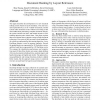Free Online Productivity Tools
i2Speak
i2Symbol
i2OCR
iTex2Img
iWeb2Print
iWeb2Shot
i2Type
iPdf2Split
iPdf2Merge
i2Bopomofo
i2Arabic
i2Style
i2Image
i2PDF
iLatex2Rtf
Sci2ools
ICDAR
2005
IEEE
2005
IEEE
Document Ranking by Layout Relevance
This paper describes the development of a new document ranking system based on layout similarity. The user has a need represented by a set of ”wanted” documents, and the system ranks documents in the collection according to this need. Rather than performing complete document analysis, the system extracts text lines, and models layouts as relationships between pairs of these lines. This paper explores three novel feature sets to support scoring in large document collections. First, pairs of lines are used to form quadrilaterals, which are represented by their turning functions. A nonEuclidean distance is used to measure similarity. Second, the quadrilaterals are represented by 5D Euclidean vectors, and third, each line is represented by a 5D Euclidean vector. We compare the classification performance and computation speed of these three feature sets using a large database of diverse documents including forms, academic papers and handwritten pages in English and Arabic. The approac...
| Added | 24 Jun 2010 |
| Updated | 24 Jun 2010 |
| Type | Conference |
| Year | 2005 |
| Where | ICDAR |
| Authors | May Huang, Daniel DeMenthon, David S. Doermann, Lynn Golebiowski, Booz Allen Hamilton |
Comments (0)

